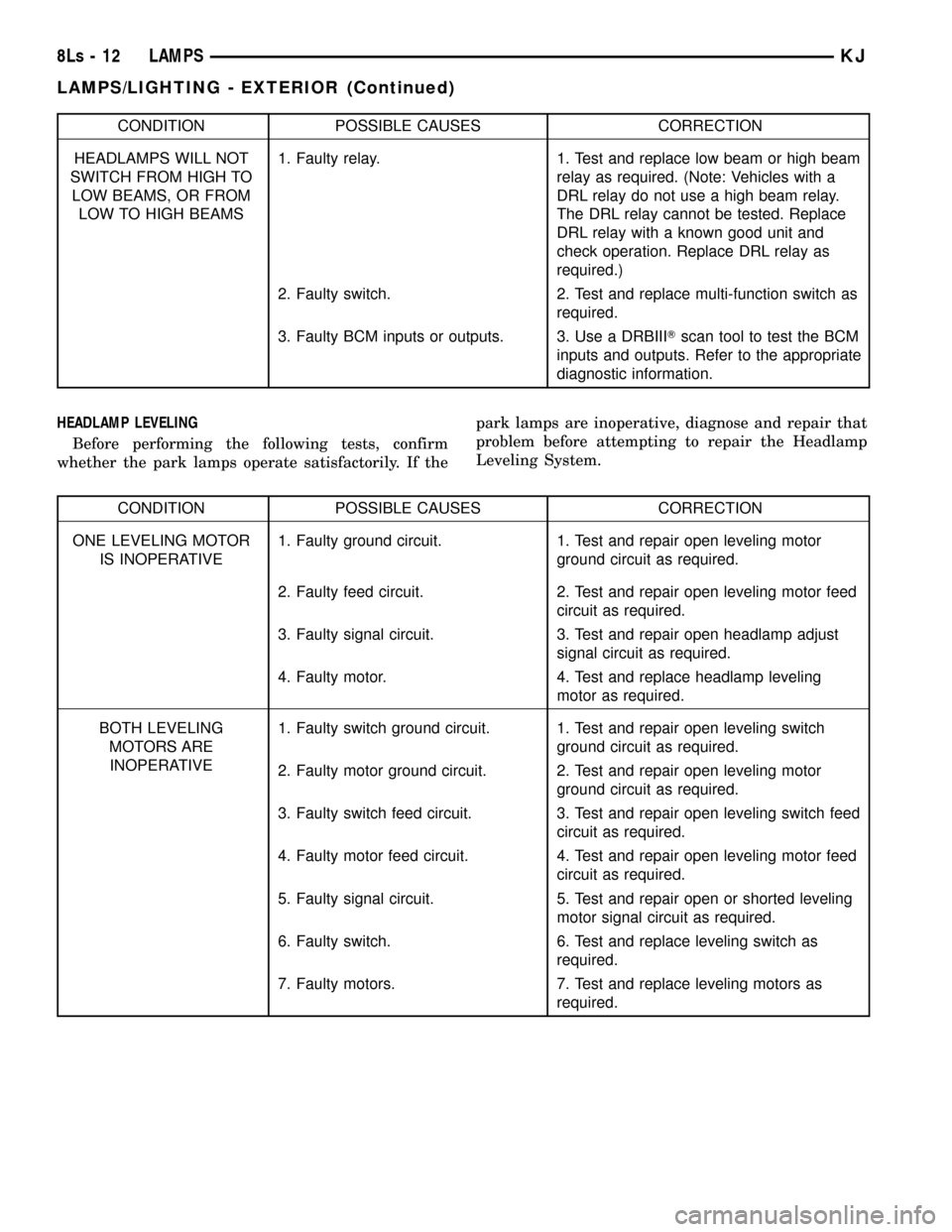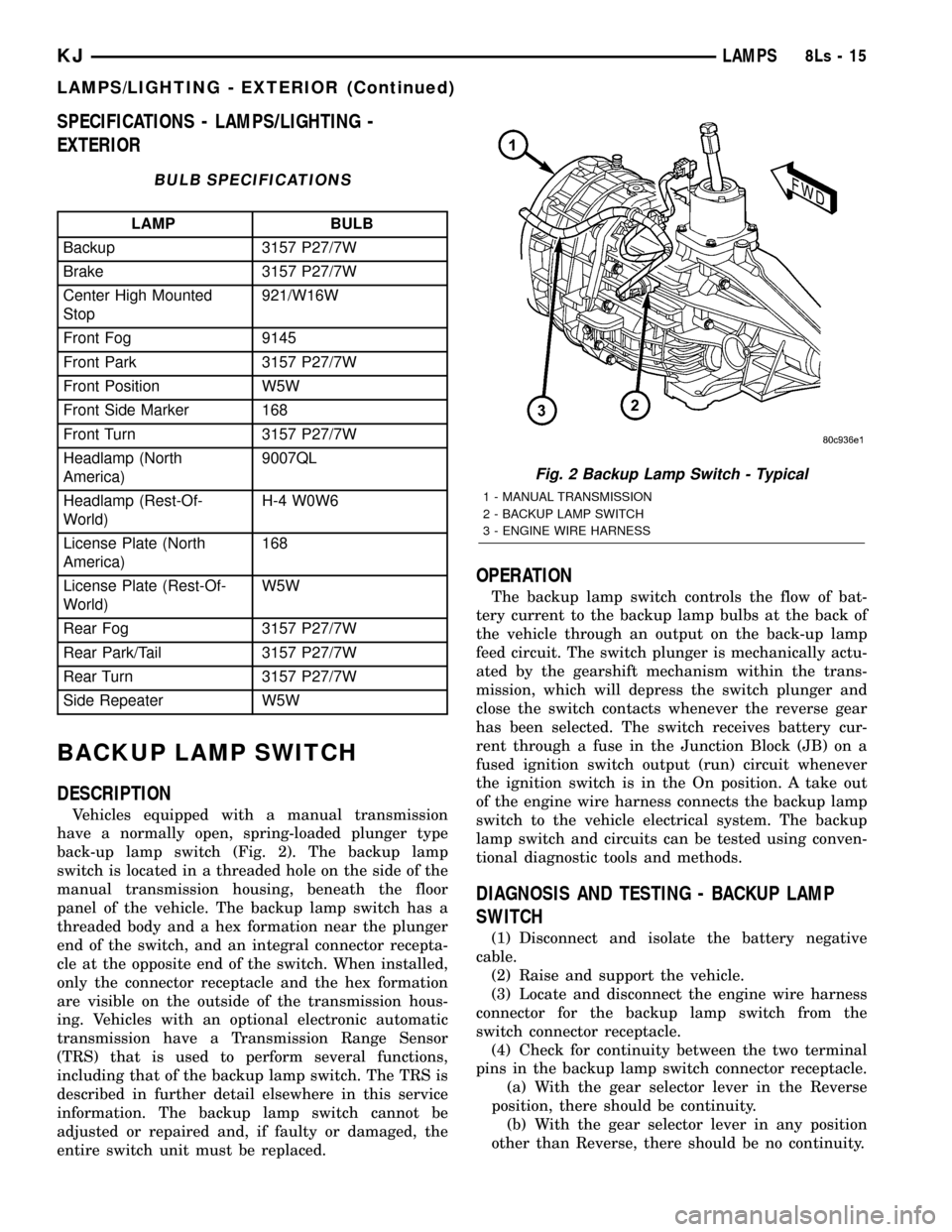headlamp JEEP LIBERTY 2002 KJ / 1.G Repair Manual
[x] Cancel search | Manufacturer: JEEP, Model Year: 2002, Model line: LIBERTY, Model: JEEP LIBERTY 2002 KJ / 1.GPages: 1803, PDF Size: 62.3 MB
Page 534 of 1803

BRAKE LAMPS
CONDITION POSSIBLE CAUSES CORRECTION
BRAKE LAMP DOES NOT
ILLUMINATE1. Faulty or missing fuse. 1. Test and replace brake lamp fuse as
required.
2. Faulty or missing bulb. 2. Test and replace brake lamp bulb as
required.
3. Faulty switch. 3. Test and replace brake lamp switch as
required.
4. Faulty ground circuit. 4. Test and repair brake lamp ground circuit
as required.
5. Faulty feed circuit. 5. Test and repair open brake lamp switch
output circuit as required.
BRAKE LAMP DOES NOT
EXTINGUISH1. Faulty switch. 1. Test and replace brake lamp switch as
required.
2. Faulty feed circuit. 2. Test and repair shorted brake lamp
switch output circuit as required.
DAYTIME RUNNING LAMPS
Before performing the following tests, determine
whether the headlamp low and high beams operate.If the headlamp high and low beams are also inoper-
ative, diagnose and repair that problem before
attempting to repair the Daytime Running Lamps.
CONDITION POSSIBLE CAUSES CORRECTION
DAYTIME RUNNING
LAMPS WILL NOT
ILLUMINATE1. High beam relay installed. 1. Remove high beam relay as required.
2. Faulty or missing DRL relay. 2. Replace DRL relay with a known good
unit and check operation. Replace DRL
relay as required.
3. Incorrect BCM programming. 3. Use a DRBIIITscan tool to check and
program correct country code into BCM as
required.
4. Faulty BCM inputs or outputs. 4. Use a DRBIIITscan tool to test the BCM
inputs or outputs. Refer to the appropriate
diagnostic information.
KJLAMPS8Ls-9
LAMPS/LIGHTING - EXTERIOR (Continued)
Page 536 of 1803

HEADLAMPS
CONDITION POSSIBLE CAUSES CORRECTION
HEADLAMP DOES NOT
ILLUMINATE1. Faulty or missing fuse. 1. Test and replace headlamp fuse as
required.
2. Faulty or missing bulb. 2. Test and replace headlamp bulb as
required.
3. Faulty or missing relay. 3. Test and replace low beam or high beam
relay as required. (Note: Vehicles with a
DRL relay do not use a high beam relay.
The DRL relay cannot be tested. Replace
DRL relay with a known good unit and
check operation. Replace DRL relay as
required.)
4. Faulty switch. 4. Test and replace multi-function switch as
required.
5. Faulty ground circuit. 5. Test and repair open headlamp ground
circuit as required.
6. Faulty feed circuit. 6. Test and repair open headlamp low
beam, high beam, or DRL relay output
circuit as required.
7. Faulty BCM inputs or outputs. 7. Use a DRBIIITscan tool to test the BCM
inputs and outputs. Refer to the appropriate
diagnostic information.
HEADLAMP DOES NOT
EXTINGUISH1. Faulty relay. 1. Test and replace low beam or high beam
relay as required. (Note: Vehicles with a
DRL relay do not use a high beam relay.
The DRL relay cannot be tested. Replace
DRL relay with a known good unit and
check operation. Replace DRL relay as
required.)
2. Faulty switch. 2. Test and replace multi-function switch as
required.
3. Faulty feed circuit. 3. Test and repair shorted headlamp low
beam, high beam, or DRL relay output
circuit as required.
4. Faulty BCM inputs or outputs. 4. Use a DRBIIITscan tool to test the BCM
inputs and outputs. Refer to the appropriate
diagnostic information.
KJLAMPS8Ls-11
LAMPS/LIGHTING - EXTERIOR (Continued)
Page 537 of 1803

CONDITION POSSIBLE CAUSES CORRECTION
HEADLAMPS WILL NOT
SWITCH FROM HIGH TO
LOW BEAMS, OR FROM
LOW TO HIGH BEAMS1. Faulty relay. 1. Test and replace low beam or high beam
relay as required. (Note: Vehicles with a
DRL relay do not use a high beam relay.
The DRL relay cannot be tested. Replace
DRL relay with a known good unit and
check operation. Replace DRL relay as
required.)
2. Faulty switch. 2. Test and replace multi-function switch as
required.
3. Faulty BCM inputs or outputs. 3. Use a DRBIIITscan tool to test the BCM
inputs and outputs. Refer to the appropriate
diagnostic information.
HEADLAMP LEVELING
Before performing the following tests, confirm
whether the park lamps operate satisfactorily. If thepark lamps are inoperative, diagnose and repair that
problem before attempting to repair the Headlamp
Leveling System.
CONDITION POSSIBLE CAUSES CORRECTION
ONE LEVELING MOTOR
IS INOPERATIVE1. Faulty ground circuit. 1. Test and repair open leveling motor
ground circuit as required.
2. Faulty feed circuit. 2. Test and repair open leveling motor feed
circuit as required.
3. Faulty signal circuit. 3. Test and repair open headlamp adjust
signal circuit as required.
4. Faulty motor. 4. Test and replace headlamp leveling
motor as required.
BOTH LEVELING
MOTORS ARE
INOPERATIVE1. Faulty switch ground circuit. 1. Test and repair open leveling switch
ground circuit as required.
2. Faulty motor ground circuit. 2. Test and repair open leveling motor
ground circuit as required.
3. Faulty switch feed circuit. 3. Test and repair open leveling switch feed
circuit as required.
4. Faulty motor feed circuit. 4. Test and repair open leveling motor feed
circuit as required.
5. Faulty signal circuit. 5. Test and repair open or shorted leveling
motor signal circuit as required.
6. Faulty switch. 6. Test and replace leveling switch as
required.
7. Faulty motors. 7. Test and replace leveling motors as
required.
8Ls - 12 LAMPSKJ
LAMPS/LIGHTING - EXTERIOR (Continued)
Page 540 of 1803

SPECIFICATIONS - LAMPS/LIGHTING -
EXTERIOR
BULB SPECIFICATIONS
LAMP BULB
Backup 3157 P27/7W
Brake 3157 P27/7W
Center High Mounted
Stop921/W16W
Front Fog 9145
Front Park 3157 P27/7W
Front Position W5W
Front Side Marker 168
Front Turn 3157 P27/7W
Headlamp (North
America)9007QL
Headlamp (Rest-Of-
World)H-4 W0W6
License Plate (North
America)168
License Plate (Rest-Of-
World)W5W
Rear Fog 3157 P27/7W
Rear Park/Tail 3157 P27/7W
Rear Turn 3157 P27/7W
Side Repeater W5W
BACKUP LAMP SWITCH
DESCRIPTION
Vehicles equipped with a manual transmission
have a normally open, spring-loaded plunger type
back-up lamp switch (Fig. 2). The backup lamp
switch is located in a threaded hole on the side of the
manual transmission housing, beneath the floor
panel of the vehicle. The backup lamp switch has a
threaded body and a hex formation near the plunger
end of the switch, and an integral connector recepta-
cle at the opposite end of the switch. When installed,
only the connector receptacle and the hex formation
are visible on the outside of the transmission hous-
ing. Vehicles with an optional electronic automatic
transmission have a Transmission Range Sensor
(TRS) that is used to perform several functions,
including that of the backup lamp switch. The TRS is
described in further detail elsewhere in this service
information. The backup lamp switch cannot be
adjusted or repaired and, if faulty or damaged, the
entire switch unit must be replaced.
OPERATION
The backup lamp switch controls the flow of bat-
tery current to the backup lamp bulbs at the back of
the vehicle through an output on the back-up lamp
feed circuit. The switch plunger is mechanically actu-
ated by the gearshift mechanism within the trans-
mission, which will depress the switch plunger and
close the switch contacts whenever the reverse gear
has been selected. The switch receives battery cur-
rent through a fuse in the Junction Block (JB) on a
fused ignition switch output (run) circuit whenever
the ignition switch is in the On position. A take out
of the engine wire harness connects the backup lamp
switch to the vehicle electrical system. The backup
lamp switch and circuits can be tested using conven-
tional diagnostic tools and methods.
DIAGNOSIS AND TESTING - BACKUP LAMP
SWITCH
(1) Disconnect and isolate the battery negative
cable.
(2) Raise and support the vehicle.
(3) Locate and disconnect the engine wire harness
connector for the backup lamp switch from the
switch connector receptacle.
(4) Check for continuity between the two terminal
pins in the backup lamp switch connector receptacle.
(a) With the gear selector lever in the Reverse
position, there should be continuity.
(b) With the gear selector lever in any position
other than Reverse, there should be no continuity.
Fig. 2 Backup Lamp Switch - Typical
1 - MANUAL TRANSMISSION
2 - BACKUP LAMP SWITCH
3 - ENGINE WIRE HARNESS
KJLAMPS8Ls-15
LAMPS/LIGHTING - EXTERIOR (Continued)
Page 545 of 1803

system. Constant battery voltage is supplied to the
flasher so that it can perform the hazard warning func-
tion, and ignition switched battery voltage is supplied
for the turn signal function. The Integrated Circuit (IC)
within the combination flasher contains the logic that
controls the flasher operation and the flash rate. The
IC receives separate sense ground inputs from the
multi-function switch for the right and left turn sig-
nals, and from the hazard switch contacts or the BCM
for the hazard warning signals. A special design feature
of the combination flasher allows it to9sense9that a
turn signal circuit or bulb is not operating, and provide
the driver an indication of the condition by flashing the
remaining bulbs in the affected circuit at a higher rate
(120 flashes-per-minute or higher). Conventional flash-
ers either continue flashing at their typical rate (heavy-
duty type), or discontinue flashing the affected circuit
entirely (standard-duty type).
Because of the active electronic elements within
the combination flasher, it cannot be tested with con-
ventional automotive electrical test equipment. If the
combination flasher is believed to be faulty, test the
turn signal and hazard warning system. Then
replace the hazard switch with a known good unit to
confirm system operation.
DAYTIME RUNNING LAMP
RELAY
DESCRIPTION
The Daytime Running Lamp (DRL) relay (Fig. 8) is
a solid state relay that is used only on vehicles man-
ufactured for sale in Canada. The DRL relay featuresa die cast aluminum housing with integral cooling
fins that act as a heat sink for the solid state DRL
circuitry. Four male spade terminals extend from the
base of the relay through a potting material that
encloses and protects the DRL circuitry. Although the
DRL relay has four terminals that are laid out in a
footprint that is similar to that of a conventional
International Standards Organization (ISO) relay, a
standard ISO relay should never be installed in place
of the DRL relay. The DRL relay is installed in the
Junction Block (JB) on the driver side outboard end
of the instrument panel. Vehicles equipped with this
relay do not have a headlamp high beam relay
installed in the JB.
The DRL relay cannot be adjusted or repaired and,
if faulty or damaged, the unit must be replaced.
OPERATION
The Daytime Running Lamp (DRL) relay is a solid
state relay that controls the flow of battery current
to the high beam filaments of both headlamp bulbs
based upon a duty cycled control input received from
the Body Control Module (BCM) of vehicles equipped
with the DRL feature. By cycling the DRL relay out-
put, the BCM controls the illumination intensity of
the high beam filaments. The DRL relay terminals
are connected to the vehicle electrical system through
a connector receptacle in the Junction Block (JB).
The inputs and outputs of the DRL relay include:
²Battery Current Input- The DRL relay
receives battery current on a fused B(+) circuit from
a fuse in the Power Distribution Center (PDC).
²Ground Input- The DRL relay receives a path
to ground through a splice block located in the
instrument panel wire harness with an eyelet termi-
nal connector that is secured by a nut to a ground
stud on the driver side instrument panel end bracket
near the Junction Block (JB).
²Control Input- The DRL relay control input is
received from the BCM and/or the momentary optical
horn (flash-to-pass) output of the multi-function
switch through a high beam relay control circuit.
²Control Output- The DRL relay supplies bat-
tery current output to the headlamp high beam fila-
ments through the high beam relay output circuit.
Because of active electronic elements within the
DRL relay, it cannot be tested with conventional
automotive electrical test equipment. If the DRL
relay is believed to be faulty, replace the relay with a
known good unit to confirm system operation.
Fig. 8 Daytime Running Lamp Relay
1 - DRL RELAY
2 - HEAT SINK
3 - POTTING MATERIAL
4 - TERMINAL (4)
8Ls - 20 LAMPSKJ
COMBINATION FLASHER (Continued)
Page 552 of 1803

FRONT LAMP BULB
REMOVAL
The front lamp unit may contain either one or two
bulbs, depending upon the market for which the
vehicle was manufactured. The service procedures for
one bulb or for both bulbs is the same, only the bulb
sizes and types may differ. Be certain any removed
bulb is replaced with the same bulb size and type
that was removed.
(1) Disconnect and isolate the battery negative
cable.
(2) Remove the front lamp unit from the front
bumper fascia. (Refer to 8 - ELECTRICAL/LAMPS/
LIGHTING - EXTERIOR/FRONT LAMP UNIT -
REMOVAL).
(3) Firmly grasp the socket on the back of the
front lamp unit housing for the bulb that is being
removed (Fig. 18).
(4) Rotate the socket on the back of the front lamp
unit housing counterclockwise about 30 degrees.
(5) Pull the socket and bulb straight out of the
back of the front lamp unit housing.
(6) Pull the bulb straight out of the front lamp
unit socket.
INSTALLATION
CAUTION: Always use the correct bulb size and
type for replacement. An incorrect bulb size or type
may overheat and cause damage to the lamp, the
socket and/or the lamp wiring.(1) Align the base of the bulb with the receptacle
in the front lamp unit socket.
(2) Push the bulb straight into the front lamp unit
socket until it is firmly seated.
(3)
Align the socket and bulb with the socket opening
on the back of the front lamp unit housing (Fig. 18).
(4) Push the socket and bulb straight into the
front lamp unit housing until it is firmly seated.
(5) Rotate the socket on the back of the front lamp
unit housing clockwise about 30 degrees.
(6) Reinstall the front lamp unit into the front
bumper fascia. (Refer to 8 - ELECTRICAL/LAMPS/
LIGHTING - EXTERIOR/FRONT LAMP UNIT -
INSTALLATION).
(7) Reconnect the battery negative cable.
FRONT LAMP UNIT
REMOVAL
(1) Disconnect and isolate the battery negative
cable.
(2) Remove the screw that secures the outboard
end of the front lamp unit to the front bumper fascia
(Fig. 19).
(3) Pull the outboard end of the front lamp unit
away from the front bumper fascia far enough to dis-
engage the tab on the inboard end of the front lamp
unit housing from the receptacle in the fascia.
(4) Pull the front lamp unit away from the front
bumper fascia far enough to access and disconnect
the wire harness connector(s) for the front lamp unit
from the lamp socket pigtail wire(s).
(5) Remove the front lamp unit from the front
bumper fascia.
Fig. 18 Front Lamp Bulb Remove/Install
1 - FRONT LAMP UNIT
2 - SIDE MARKER SOCKET
3 - FRONT FASCIA
4 - HEADLAMP & DASH WIRE HARNESS
5 - MOUNTING TAB
6 - PARK/TURN SIGNAL SOCKET
Fig. 19 Front Lamp Unit Remove/Install
1 - FRONT LAMP UNIT
2 - FRONT BUMPER FASCIA
3 - SCREW (1)
KJLAMPS8Ls-27
Page 553 of 1803

INSTALLATION
(1) Position the front lamp unit to the front
bumper fascia.
(2) Reconnect the wire harness connector(s) for the
front lamp unit to the lamp socket pigtail wire(s).
(3) Engage the tab on the inboard end of the front
lamp unit housing into the receptacle in the front
bumper fascia.
(4) Position the outboard end of the front lamp
unit housing to the front bumper fascia.
(5) Install and tighten the screw that secures the
outboard end of the front lamp unit housing to the
front bumper fascia (Fig. 19). Tighten the screw to 2
N´m (20 in. lbs.).
(6) Reconnect the battery negative cable.
FRONT POSITION LAMP BULB
REMOVAL
The front position lamps are integral to the head-
lamp units on vehicles manufactured for certain mar-
kets where these lamps are required.
(1) Disconnect and isolate the battery negative
cable.
(2) Remove the headlamp unit from the front grille
opening reinforcement. (Refer to 8 - ELECTRICAL/
LAMPS/LIGHTING - EXTERIOR/HEADLAMP UNIT
- REMOVAL).
(3) Rotate the front position lamp socket near the
bottom of the headlamp unit housing counterclock-
wise about 30 degrees (Fig. 20).
(4) Pull the socket and bulb straight out of the
headlamp unit housing.(5) Pull the bulb straight out of the front position
lamp socket.
INSTALLATION
The front position lamps are integral to the head-
lamp units on vehicles manufactured for certain mar-
kets where these lamps are required.
CAUTION: Always use the correct bulb size and
type for replacement. An incorrect bulb size or type
may overheat and cause damage to the lamp, the
socket and/or the lamp wiring.
(1) Align the base of the bulb with the receptacle
in the front position lamp socket.
(2) Push the bulb straight into the front position
lamp socket until it is firmly seated.
(3) Align the socket and bulb with the socket open-
ing near the bottom of the headlamp unit housing
(Fig. 20).
(4) Push the socket and bulb straight into the
headlamp unit housing until it is firmly seated
(5) Rotate the front position lamp socket near the
bottom of the headlamp unit housing clockwise about
30 degrees.
(6) Reinstall the headlamp unit onto the grille
opening reinforcement. (Refer to 8 - ELECTRICAL/
LAMPS/LIGHTING - EXTERIOR/HEADLAMP UNIT
- INSTALLATION).
(7) Reconnect the battery negative cable.
(8) Confirm proper headlamp unit alignment.
(Refer to 8 - ELECTRICAL/LAMPS/LIGHTING -
EXTERIOR/HEADLAMP UNIT - ADJUSTMENTS).
HAZARD SWITCH
DESCRIPTION
The hazard switch is integral to the hazard switch
module, which is secured near the center of instru-
ment panel just above the radio (Fig. 21). Only the
hazard switch button is visible through a dedicated,
round, beveled opening on the outer surface of the
instrument panel between the two center panel out-
lets of the heater and air conditioning system. A red,
stencil-like International Control and Display Symbol
icon for ªHazard Warningº identifies the hazard
switch button. On the opposite end of the black,
molded plastic hazard switch module housing from
the switch button is an integral connector receptacle
and a stamped steel mounting bracket with two latch
feature tabs that extend downward, while a short
dowel-like alignment pin is integral to each side of
the housing just below the switch button. The switch
module is connected to the vehicle electrical system
through a dedicated take out and connector of the
instrument panel wire harness. Within the hazard
Fig. 20 Front Position Lamp Bulb Remove/Install
1 - HEADLAMP HOUSING
2 - SOCKET
3 - BULB
8Ls - 28 LAMPSKJ
FRONT LAMP UNIT (Continued)
Page 555 of 1803

(2) Remove the radio from the instrument panel.
(Refer to 8 - ELECTRICAL/AUDIO/RADIO -
REMOVAL).
(3) Remove the screw at the top of the instrument
panel radio opening that secures the hazard switch
to the instrument panel trim (Fig. 22).
(4) Reach through and above the instrument panel
radio opening to access the two latch tabs of the
stamped metal hazard switch mounting bracket.
(5) Using two fingertips, pull rearward and down-
ward on the latch tabs on the back of the hazard
switch until it is disengaged from the instrument
panel trim.
(6) Push the hazard switch button through the
button opening of the instrument panel far enough to
disengage the alignment pins on each side of the
switch housing from the saddle formations of the two
stanchions on the back of the instrument panel trim,
just below and to either side of the button opening.
(7) Disconnect the instrument panel wire harness
connector for the hazard switch from the switch con-
nector receptacle.
(8) Remove the hazard switch through the instru-
ment panel radio opening.
INSTALLATION
WARNING: ON VEHICLES EQUIPPED WITH AIR-
BAGS, DISABLE THE SUPPLEMENTAL RESTRAINT
SYSTEM BEFORE ATTEMPTING ANY STEERING
WHEEL, STEERING COLUMN, DRIVER AIRBAG,PASSENGER AIRBAG, SEAT BELT TENSIONER,
FRONT IMPACT SENSORS, SIDE CURTAIN AIRBAG,
OR INSTRUMENT PANEL COMPONENT DIAGNOSIS
OR SERVICE. DISCONNECT AND ISOLATE THE
BATTERY NEGATIVE (GROUND) CABLE, THEN
WAIT TWO MINUTES FOR THE SYSTEM CAPACI-
TOR TO DISCHARGE BEFORE PERFORMING FUR-
THER DIAGNOSIS OR SERVICE. THIS IS THE ONLY
SURE WAY TO DISABLE THE SUPPLEMENTAL
RESTRAINT SYSTEM. FAILURE TO TAKE THE
PROPER PRECAUTIONS COULD RESULT IN ACCI-
DENTAL AIRBAG DEPLOYMENT AND POSSIBLE
PERSONAL INJURY.
(1) Position the hazard switch through the instru-
ment panel radio opening.
(2) Reconnect the instrument panel wire harness
connector for the hazard switch to the switch connec-
tor receptacle.
(3) Reach through and above the instrument panel
radio opening to position the hazard switch for
installation.
(4) Guide the hazard switch button through the
button opening of the instrument panel, which will
engage the alignment pins on each side of the switch
housing with the saddle formations of the two stan-
chions on the back of the instrument panel trim, just
below and to either side of the button opening.
(5) Using hand pressure, press upward on the
back of the hazard switch until the latch tabs of the
mounting bracket on the back of the switch are both
engaged with the instrument panel trim (Fig. 22).
(6) Install and tighten the screw at the top of the
instrument panel radio opening that secures the haz-
ard switch to the instrument panel trim. Tighten the
screw to 2 N´m (17 in. lbs.).
(7) Reinstall the radio into the instrument panel.
(Refer to 8 - ELECTRICAL/AUDIO/RADIO -
INSTALLATION).
(8) Reconnect the battery negative cable.
HEADLAMP BULB
REMOVAL
NORTH AMERICA
(1) Disconnect and isolate the battery negative
cable.
(2) Reach behind the headlamp unit from the
engine compartment side of the upper radiator cross-
member to access the headlamp bulb lock ring (Fig.
23).
(3) Firmly grasp the lock ring on the back of the
headlamp unit housing.
Fig. 22 Hazard Switch Remove/Install
1 - WIRE HARNESS CONNECTOR
2 - HAZARD SWITCH
3 - ALIGNMENT PIN (2)
4 - STANCHION (2)
5 - INSTRUMENT PANEL
6 - SCREW (1)
7 - MOUNTING BRACKET LATCH TAB (2)
8Ls - 30 LAMPSKJ
HAZARD SWITCH (Continued)
Page 556 of 1803

(4) Rotate the lock ring on the back of the head-
lamp unit housing counterclockwise about 30
degrees.
CAUTION: Do not contaminate the bulb glass by
touching it with your fingers or by allowing it to
contact other oily surfaces. Shortened bulb life will
result.
(5) Pull the lock ring, socket, and bulb straight out
of the headlamp unit housing and up from behind
the upper radiator crossmember (Fig. 24).(6) Disconnect the grille opening reinforcement
wire harness connector for the headlamp bulb from
the connector receptacle on the bulb socket.
(7) Remove the bulb and bulb socket from the lock
ring as a unit.
REST-OF-WORLD
(1) Disconnect and isolate the battery negative
cable.
(2) Remove the headlamp unit from the grille
opening reinforcement. (Refer to 8 - ELECTRICAL/
LAMPS/LIGHTING - EXTERIOR/HEADLAMP UNIT
- REMOVAL).
(3) Firmly grasp the tab of the headlamp boot seal
on the back of the headlamp unit housing (Fig. 25).
(4) Pull the tab away from the back of the head-
lamp unit housing to remove the boot seal from the
housing and the bulb base.
(5) Pinch the two hooked ends of the wire head-
lamp bulb retainer clip together and disengage them
from the slots in the flange of the reflector (Fig. 26).
(6) Pivot the headlamp bulb retainer clip up off of
the bulb flange and out of the way.
CAUTION: Do not contaminate the bulb glass by
touching it with your fingers or by allowing it to
contact other oily surfaces. Shortened bulb life will
result.
Fig. 23 Headlamp Bulb Lock Ring
1 - HEADLAMP UNIT HOUSING
2 - LOCK RING
3 - SOCKET & BULB
Fig. 24 Headlamp Bulb Remove/Install
1 - HEADLAMP BULB
2 - SOCKET
3 - LOCK RING
Fig. 25 Headlamp Bulb Boot Seal Remove
1 - LEVELING MOTOR (IF EQUIPPED)
2 - BOOT SEAL
3 - FRONT POSITION LAMP
4 - ADJUSTING SCREW
5-TAB
6 - BULB BASE
KJLAMPS8Ls-31
HEADLAMP BULB (Continued)
Page 557 of 1803

(7) Pull the bulb straight out of the headlamp unit
reflector (Fig. 27).
INSTALLATION
NORTH AMERICA
CAUTION: Always use the correct bulb size and
type for replacement. An incorrect bulb size or type
may overheat and cause damage to the lamp, the
socket and/or the lamp wiring.
CAUTION: Do not contaminate the bulb glass by
touching it with your fingers or by allowing it to
contact other oily surfaces. Shortened bulb life will
result.
(1) Position the headlamp bulb and socket unit
into the lock ring (Fig. 24).
(2) Reconnect the grille opening reinforcement
wire harness connector for the headlamp bulb to the
connector receptacle on the bulb socket.
(3) Position the lock ring, socket, and bulb down
behind the upper radiator crossmember and align
them with the socket opening on the back of the
headlamp unit housing.
(4) Push the socket and bulb straight into the
headlamp unit housing until they are firmly seated.
(5) Position the lock ring over the socket and
engage it with the flange on the back of the head-
lamp unit housing (Fig. 23).
(6) Rotate the lock ring on the back of the head-
lamp unit housing clockwise about 30 degrees.
(7) Reconnect the battery negative cable.
REST-OF-WORLD
CAUTION: Always use the correct bulb size and
type for replacement. An incorrect bulb size or type
may overheat and cause damage to the lamp, the
socket and/or the lamp wiring.
CAUTION: Do not contaminate the bulb glass by
touching it with your fingers or by allowing it to
contact other oily surfaces. Shortened bulb life will
result.
(1) Position the bulb into the headlamp unit reflec-
tor (Fig. 27).
(2) Pivot the headlamp bulb retainer clip back over
the bulb flange.
(3) Pinch the two hooked ends of the wire head-
lamp bulb retainer clip together and engage them
into the slots in the flange of the reflector (Fig. 26).
(4) Position the center opening of the boot seal
over the base of the headlamp bulb and pull it down-
ward until the seal is fully engaged over the bulb
base (Fig. 25).
Fig. 26 Headlamp Bulb Retainer Clip Engage/
Disengage
1 - RETAINER CLIP
2 - BULB BASE
3 - HEADLAMP HOUSING
4 - REFLECTOR
5 - BULB FLANGE
6 - RETAINER SLOTS
Fig. 27 Headlamp Bulb Remove/Install
1 - BULB BASE
2 - RETAINER CLIP
3 - LEVELING MOTOR (IF EQUIPPED)
4 - REFLECTOR
5 - HEADLAMP HOUSING
6 - BULB FLANGE
8Ls - 32 LAMPSKJ
HEADLAMP BULB (Continued)